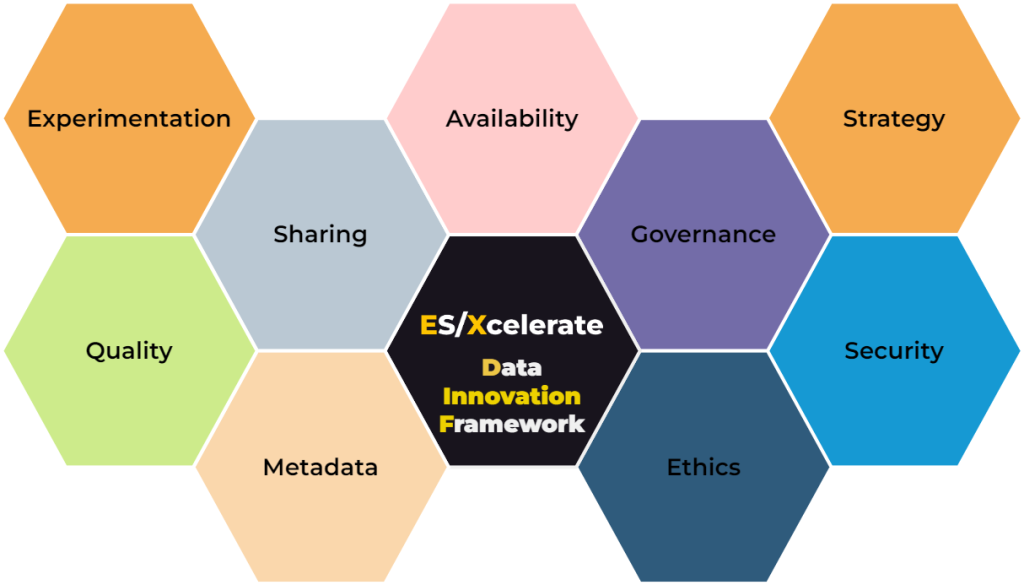Data is the new oil, and data innovation is the key to unlocking its value. Data innovation refers to the use of data and analytics to develop or foster new products, processes, organizational methods and markets. Data innovation can drive both the discovery and execution of innovation, achieving new business models, products and services with a confirmed business value.
However, data innovation is not easy. It requires a clear and coherent data strategy, a robust data governance framework, a high level of data quality and metadata, a culture of data experimentation, and a respect for data ethics. Moreover, data innovation needs to be aligned with the business goals and vision, and supported by the appropriate data infrastructure, tools, and platforms.
This is where the ES/Xcelerate Data&AI Innovation Framework comes in. This framework is a systematic approach to data innovation, developed by Nilay Parikh, a data and AI expert and the founder of ErgoSum / X Labs.

© Nilay Parikh. All rights reserved. No warranty or liability implied.
The framework consists of nine principles for data innovation, as well as a set of key aspects that define the measurable maturity, criteria, assessment, risks, effectiveness, applicability, alignment, business goals, data-driven excellence, indicators, trust, credibility, evidence, alignment, and business goals of each principle. The framework provides a holistic and practical guide for data innovation, and helps organizations to build mature, effective, and ethical data and AI solutions and designs.
| Principle | Description |
| Strategy | Create a clear and coherent data strategy that aligns with the business goals and vision, and defines the data requirements, priorities, and standards for data innovation. |
| Governance | Establish a data governance framework that defines the roles, responsibilities, and accountabilities for data innovation, and ensures ethical, legal, and transparent data management practices. |
| Quality | Ensure data quality throughout the data lifecycle, by applying data validation, verification, and cleaning methods, and by monitoring and reporting on data quality metrics and issues. |
| Metadata | Collect and analyze metadata for all data assets, to provide information on the data origin, context, structure, meaning, quality, and usage, and to facilitate data discovery, integration, and reuse. |
| Experimentation | Enable data experimentation by providing access to data, tools, and platforms that support advanced analytics, AI, and ML, and by fostering a culture of data literacy, curiosity, and innovation. |
| Security | Protect data from unauthorized access, modification, or deletion, by implementing data encryption, authentication, authorization, and auditing mechanisms, and by complying with data privacy and security regulations. |
| Availability | Ensure data is accessible and usable by authorized users whenever and wherever they need it, by providing reliable data storage, backup, and recovery solutions, and by optimizing data performance and scalability. |
| Sharing | Facilitate data sharing and collaboration among internal and external stakeholders, by establishing data exchange standards, protocols, and platforms, and by promoting data interoperability and openness. |
| Ethics | Respect the rights and interests of data owners, providers, and users, by adhering to ethical principles and values, such as fairness, transparency, accountability, and trustworthiness, and by avoiding data misuse or abuse. |

Executive layer, providing succinct architectural insights through graphical representations and value-driven roadmaps. Align organizational data strategies with business goals, offering transparent views of budgetary, risk, and capability trade-offs.

Design layer for comprehensive architectural principles, design patterns, and technical recommendations. Tailored for architects and engineers, it guides through modern best practices, balancing quality, cost, and agility for robust implementations.

Data governance teams find their compass in the Controls layer, offering predefined audit controls, risk indicators, and capability maturity blueprints. Quantify operational metrics, ensuring a rigorous approach to quality, compliance, and usage across data processes.
License
This work (ES/Xcelerate Framework) by Nilay Parikh is licensed under CC BY 4.0 or view a human-readable summary.
If the above licenses do not suit your needs, please contact us at [email protected] to discuss your terms. We also offer more flexible commercial license that do not require attribution. The different licensing approaches reflect the intellectual property and commercial considerations associated with various framework elements while still promoting access.
Disclaimer
The views expressed on this site are personal opinions only and have no affiliation. See full disclaimer, terms & conditions, and privacy policy. No obligations assumed.
